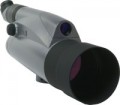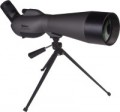Magnification
The magnification of the image provided by a telescope. Roughly speaking, this parameter describes how many times the object seen in the eyepiece of the pipe will be larger than when viewed from the same distance with the naked eye.
Multiplicity — the first number (numbers) in the digital marking of optical instruments: for example, the designation 25-75x50 corresponds to a multiplicity from 25x to 75x. Note that most modern telescopes have variable (adjustable) magnification. This allows you to choose the mode of operation depending on the situation: to search for the desired object, it is more convenient to reduce the magnification, providing a wide field of view, and having found it, increase the magnification and examine in detail. However in some models, to change the magnification, you need to replace the eyepiece (see "Replacement eyepiece").
High magnification, on the one hand, makes the tube "long-range" and makes it easy to examine small objects at considerable distances. On the other hand, the angle of view decreases in this case, which makes it difficult to observe moving objects and even aim the optics at the target. In addition, with an increase in the magnification, the diameter of the exit pupil also decreases (see below) and the aperture ratio of the tube; you can compensate for this moment by increasing the lens, but this accordingly affects the price. So it makes sense to specifically look for powerful optics with a high degree of ma...gnification only when such capabilities are fundamentally important.
Optical system
The type of optical system used in a telescope.
The optical system is a set of lenses and other elements responsible for processing the image entering the eyepiece. Such systems may be of the following types:
—
Lens. She's a refractor. Optical systems based solely on lenses. Such systems are relatively simple, inexpensive and at the same time quite functional. Image quality, however, turns out to be somewhat lower than in mirror-lens systems, and with a magnification factor of more than 60x, it deteriorates even more; therefore, lens systems usually have relatively low magnification. In addition, they are longer and heavier. On the other hand, optical devices of this design are quite unpretentious in handling and resistant to shock and shock (although this is still better to avoid); and the mentioned high multiplicity is rarely required in fact. Thus, most modern telescopes use this type of optic.
—
Mirror lens. This category includes optical systems built on the basis of concave mirrors (which provide the main increase) and corrective lenses designed to eliminate the distortion that inevitably occurs when using mirrors. One of the key advantages of such systems over lens systems is a clearer image, even at high magnifications — the magnification of telescopes of this type can reach 200x without compromising image quality. In addition, with the same focal length, the body o
...f the device can be made much shorter, more compact and lighter. At the same time, mirror-lens systems are expensive and turn out to be rather fragile (however, the latter can be partly compensated for by a rubberized housing and other methods of shock protection). Spyglasses of this type are relatively rare, it is believed that they are better suited for observations at high magnification (including for use as an impromptu telescope).Field of view 1 km away
The field of view of the telescope at a distance of 1 km to the objects under consideration, the so-called "linear field of view". In fact, this is the width (diameter) of the space that falls into the field of view when observed from a distance of 1 km.
This parameter is widely used in the characteristics of telescopes along with the angular field of view (see below): the linear field of view data is more visual and closer to practice, it allows you to evaluate the capabilities of a telescope without resorting to special calculations.
For models of variable magnification (the majority of them), the linear field of view is indicated in the form of two numbers — for the minimum and for the maximum magnification.
Angle of view
Angle of view provided by a telescope.
If you draw two lines from the centre of the lens to two opposite points along the edges of the field of view of the pipe, the angle between these lines will correspond to the angular field of view. Accordingly, the larger the angle, the wider the field of view; however, individual items in it will look smaller. Conversely, an increase in magnification is inevitably associated with a decrease in the viewing angle. And since most modern telescopes have a variable magnification, the angular field of view is also variable, and in the characteristics this indicator is indicated in the form of two numbers — for the minimum and for the maximum magnification.
Diopter adjustment
The presence of
diopter correction in the design of the telescope (usually in the eyepiece of the telescope).
This function is intended for those who have vision problems and wear corrective glasses with "plus" or "minus" lenses. It is not very convenient to look into the eyepiece with glasses — in particular, the distance to the eye may be greater than the eye relief (see below), which degrades the quality of the visible image. Contact lenses can be an alternative, but they are not for everyone. Another, more convenient option is just diopter correction: it allows you to set the required number of diopters (to “plus” or “minus”) right in the eyepiece of the device and look into it with the naked eye, seeing a clear image. However the adjustment range (see below) is often relatively small, and for severe vision problems, this function may not provide the desired degree of correction. However, even in such cases, a person in need of glasses will find it much more comfortable to look through a "corrected" eyepiece; the image will be, although not perfect, but clearer than with optics settings for healthy vision.
Diopter correction range
The range over which the telescope can make diopter adjustment (see above). If the characteristics of the glasses fall within this range, the wearer will be able to see a clear picture in the eyepiece (correctly adjusted) even without glasses. If the glasses are stronger, you will either have to look into them, or take care of contact lenses, or come to terms with the fact that the visible image may not be very clear.
Eye relief
Removal of the exit pupil of a telescope.
About the exit pupil itself, see above. Here we note that the offset is such a distance from the eyepiece lens to the observer's eye, at which the size of the visible image from the lens corresponds to the visible size of the eyepiece lens. In other words, the observed "image" in this case occupies the entire space of the eyepiece, without vignetting (darkening at the edges) and without "spreading" beyond the edges of the eyepiece. In this case, the overall image quality will be the best.
When looking down the pipe with the naked eye, the observer usually has no problem getting into the offset distance, and this parameter can be ignored. Problems can arise if the user wears glasses and the diopter adjustment (see above) is not sufficient to comfortably view without glasses. In such cases, it is desirable to use models with eye relief of at least 15 mm: although such a distance will not provide the highest image quality when viewed with glasses, it will allow using the device without any special difficulties. However, in modern telescopes, this parameter can reach 18 mm or even more.
Also note that eye relief may decrease somewhat with increasing magnification; in such cases, two numbers are indicated in the characteristics, corresponding to the removal at the minimum and at the maximum magnification.
Focus
A method of focus provided in the design of a telescope.
This parameter is indicated by which control element is responsible for focus:
a screw on the body, a ring on the
body or
eyepiece, etc. However, it cannot be said that any method has fundamental advantages or disadvantages. By themselves, they are all quite functional, and the choice of the manufacturer is based primarily on which option is best suited specifically for this device. So paying attention to this parameter makes sense, first of all, for those who have certain preferences (for example, they are used to the ring on the eyepiece) and do not want to use another method.
Prism type
The type of prisms used in the construction of the telescope (if prisms are provided at all).
—
Roof. A Roof prism does not change the direction of light entering it — the light beam goes through several internal reflections and exits in the same direction and at the same level as it entered. Such prisms are used in models with a direct arrangement of the eyepiece; they allow you to increase the focal length of the telescope and achieve high magnification without a significant increase in the length of the device itself.
—
Porro. A classic prism of this type provides a "reversal" of the light entering it by 180 °; because of this, Porro are used at least in pairs. They are used in almost all telescopes with eyepieces located at 45 °, as well as in "straight" models, in which the eyepiece is offset relative to the optical axis of the lens (usually upwards). For the advantages of the first option, see "Eyepiece Positions"; and placing the eyepiece above the lens reduces the length of the telescope, moreover, in some situations, this arrangement is the most convenient. Like the Roof, Porro prisms provide an increase in focal length; however, they are considered to give a wider field of view and good image depth. The disadvantage of this option is the increase in the dimensions of the pipe in height.

